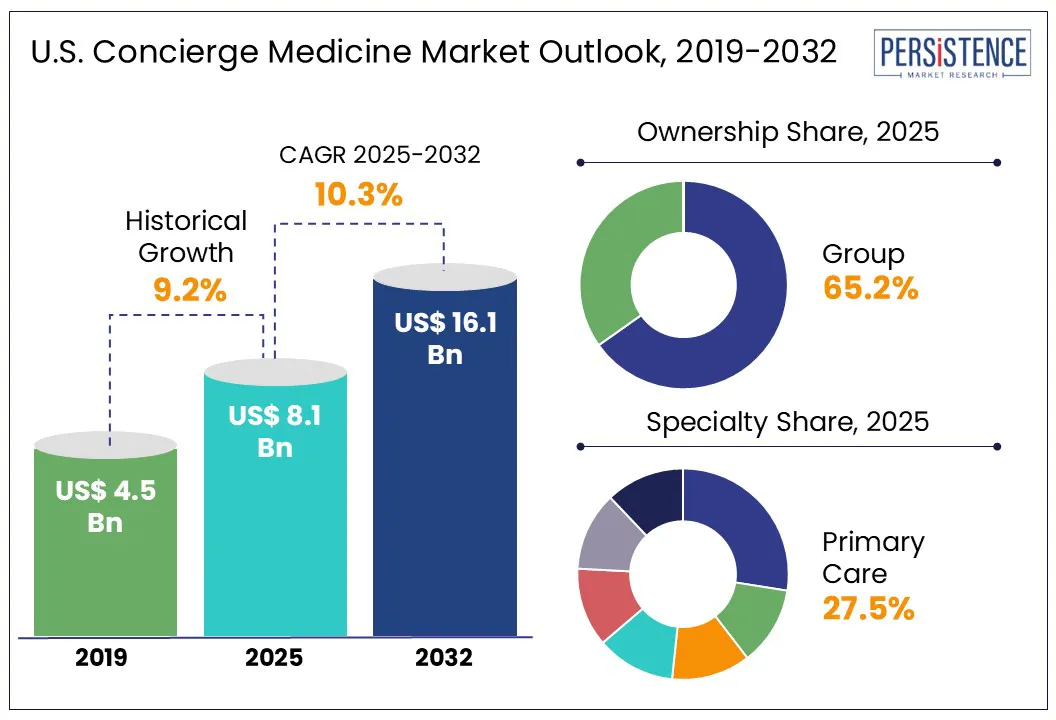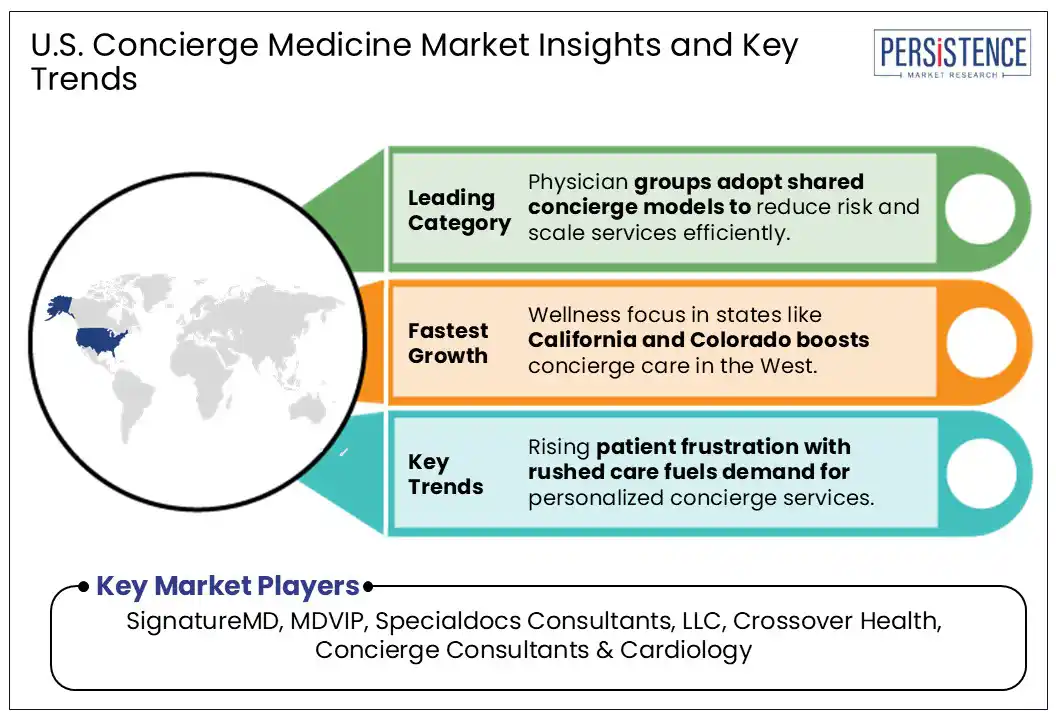ID: PMRREP35436| 142 Pages | 19 Jun 2025 | Format: PDF, Excel, PPT* | Healthcare

The U.S. concierge medicine market size is predicted to reach US$ 16.1 Bn in 2032 from US$ 8.1 Bn in 2025. It will likely witness a CAGR of around 10.3% in the forecast period between 2025 and 2032.
In a healthcare sector often criticized for its rushed appointments, rising patient dissatisfaction, and fragmented communication, concierge medicine is transforming how individuals in the U.S. engage with their doctors. Emerging as a premium alternative to traditional primary care, this model offers patients direct access to physicians through membership-based healthcare. Concierge medicine is gaining momentum not just among the affluent but also among health-conscious professionals and chronically ill patients who value time and transparency.

Key Industry Highlights:
|
Market Attribute |
Key Insights |
|
U.S. Concierge Medicine Market Size (2025E) |
US$ 8.1 Bn |
|
Market Value Forecast (2032F) |
US$ 16.1 Bn |
|
Projected Growth (CAGR 2025 to 2032) |
10.3% |
|
Historical Market Growth (CAGR 2019 to 2024) |
9.2% |
The rising demand for personalized care and enhanced healthcare access is a primary factor pushing the U.S. concierge medicine market growth, finds Persistence Market Research. Unlike standard primary care, where physicians often manage extremely large patient panels, concierge medicine limits patient loads to provide longer, unhurried visits. This personalized attention appeals strongly to individuals managing chronic conditions or those valuing preventive care, resulting in better health outcomes and higher patient satisfaction.
The Beryl Institute-Ipsos PX Pulse survey revealed that 91% of consumers in the U.S. prioritize healthcare experience, emphasizing the importance of clear communication and personalized care. It has propelled interest in concierge models, where membership fees guarantee access to coordination of specialist referrals, 24/7 primary care services, and same-day or next-day appointments. Technological innovations have further boosted this trend by enabling personalized health analytics, remote monitoring, and telemedicine.
Concierge healthcare services in the U.S. face adoption barriers mainly due to its incompatibility with traditional insurance models and the high out-of-pocket costs required for enrollment. Most concierge practices operate on a membership fee basis that typically ranges from US$ 1,500 to over US$ 5,000 annually, which is not reimbursed by Medicare or private insurers. This creates a financial barrier for middle- and low-income patients who already pay high premiums for standard insurance. According to a 2023 Kaiser Family Foundation (KFF) survey, 20% of consumers in the U.S. with Affordable Care Act (ACA) Marketplace plans reported that a provider they required was not covered by their insurance.
The lack of integration with insurance means patients often have to navigate dual systems. This fragmentation can be inconvenient and confusing, especially for older adults or individuals managing complex health conditions. The Centers for Medicare & Medicaid Services (CMS) has also issued cautionary guidance around double billing for Medicare patients in concierge models. This is further complicating physician participation and discouraging widespread adoption.
The surging demand for improved doctor-patient relationships is creating lucrative opportunities in the U.S. by offering it as a solution to the systemic dissatisfaction with rushed care in conventional primary care settings. In traditional practices, physicians often manage over 2,000 patients, limiting visit times to 10 to 15 minutes. In contrast, concierge models reduce panel sizes to around 300 to 600 patients, allowing appointments that can last 30 minutes or more. A recent online survey, for example, found that 61% of patients feel their doctors do not spend enough time with them, and 52% wish for more personalized care.
The sentiments have translated into tangible market behavior. For example, in October 2019, MDVIP, one of the most prominent concierge networks, reported surpassing 1,000 physicians and 325,000+ members. As of September 2023, its network includes over 1,100 affiliated primary-care physicians serving more than 385,000 patients. Patients are increasingly striving to gain access to a physician who knows their full medical history and can offer relationship-based care. This model specifically appeals to those managing chronic conditions as it enables consistent monitoring and trust-building.
In terms of ownership, the market is bifurcated into group and standalone. Among these, the group segment is projected to account for approximately 65.2% of the U.S. concierge medicine market share in 2025 amid its ability to provide economies of scale, operational resilience, and broad service offerings that individual practices often cannot sustain. Group-owned concierge models enable resource sharing across administrative tasks, technology infrastructure, legal compliance, and marketing. This lowers the overhead burden on individual physicians and enables them to focus on patient care while maintaining the personalized attention core to concierge models.
Standalone ownership, on the other hand, is expected to witness a considerable CAGR from 2024 to 2032. This is because it caters to physicians seeking full autonomy over clinical decisions, service structure, and pricing without the constraints of corporate oversight. Several experienced doctors prefer the standalone route as it enables them to retain their established patient base while redesigning their practice around personalized care. This model is prevalent in affluent markets where physicians have cultivated long-standing community ties and reputations.
Based on specialty, the market is segregated into primary care, internal medicine, pediatrics, cardiology, osteopathy, and psychiatry. Out of these, the primary care segment will likely hold about 27.5% of share in 2025 because it serves as the initial point of contact for patients, making it the ideal specialty for a subscription-based healthcare model. Primary care physicians are uniquely positioned to provide chronic disease management, preventive screenings, and longitudinal care, benefitting from the increased time and attention afforded by the concierge model. Primary care also enables consistent patient engagement, which is associated with the annual membership structure typical of concierge practices.
Internal medicine is another significant specialty as it caters primarily to adult patients with complex or chronic health requirements, which demand constant monitoring and management. Internists are trained to diagnose and manage multiple conditions across organ systems. This makes them valuable in concierge setups where patients expect high-touch care. The concierge model allows internists the time and flexibility to conduct longer consultations, create personalized care plans, and coordinate with specialists.

Concierge medicine in the West is witnessing steady growth due to a concentration of affluent, health-conscious populations in Colorado, Washington, and California. The zone’s tech-savvy demographics and high median incomes facilitate the adoption of concierge models that combine conventional in-person care with novel digital health tools. According to a recent study, California accounts for over 25% of the zone’s concierge practices, fueled by urban centers such as Los Angeles, San Diego, and San Francisco.
A significant trend in the West is the integration of concierge medicine with lifestyle and preventive health offerings, including fitness coaching, mental health, and nutrition. Companies such as Forward, based in San Francisco, exemplify this by blending AI-backed diagnostics with concierge care, appealing to the younger demographic. The West Coast also benefits from relatively progressive regulatory environments that allow telemedicine and hybrid care models to flourish within concierge practices.
Concierge medicine in the Southeast U.S. is emerging as a developing but relatively niche market, propelled by rising affluence in metropolitan hubs, including Nashville and Miami. Demographic shifts and increasing chronic disease burdens are creating new opportunities in the zone. Wealthy suburbs and urban centers are seeing a gradual rise in concierge practices as patients seek personalized, accessible care options due to rising dissatisfaction with long waiting times.
A distinctive feature of the Southeast market is the emphasis on concierge care for managing chronic illnesses such as cardiovascular disease and diabetes. Providers in Tampa and Charlotte are offering concierge services to deliver comprehensive chronic care management, often integrating social determinants of health into personalized plans. However, insurance limitations and lower median incomes relative to coastal states remain adoption barriers.
The Midwest is marked by steady but cautious growth, shaped by the zone’s diverse economic landscape and mixed urban-rural population distribution. Metropolitan areas, including Columbus, Minneapolis, and Chicago, are seeing increasing acceptance of concierge models. Broad adoption, however, faces challenges from lower average household incomes and a more conservative approach to healthcare spending compared to coastal areas.
Local concierge practices often emphasize value-driven care, catering to patients with chronic conditions. Providers integrate preventive medicine with accessible follow-up services, which appeal to patients frustrated by conventional primary care limitations. A 2023 survey, for instance, revealed a 7% year-over-year increase in concierge memberships in the Midwest, showcasing a gradual shift toward direct care models.
The U.S. concierge medicine market is characterized by the presence of well-established firms and niche boutique practices. They are targeting health-conscious or affluent populations dissatisfied with conventional healthcare models. Renowned networks are collaborating with independent physicians and delivering operational support, infrastructure, and marketing in exchange for a share of the membership revenue. Small-scale boutique practices are relying on exclusivity and premium services such as home visits or 24/7 physician access to attract high-net-worth clients.
The U.S. concierge medicine market is projected to reach US$ 8.1 Bn in 2025.
Increasing requirements for broad patient engagement across all age groups and surging demand for digitally integrated care are the key market drivers.
The market is poised to witness a CAGR of 10.3% from 2025 to 2032.
Rising prevalence of chronic diseases and surging demand for constant, relationship-based medical care models are the key market opportunities.
SignatureMD, MDVIP, and Specialdocs Consultants, LLC are a few key market players.
|
Report Attribute |
Details |
|
Historical Data/Actuals |
2019 - 2024 |
|
Forecast Period |
2025 - 2032 |
|
Market Analysis Units |
Value: US$ Bn/Mn, Volume: As Applicable |
|
Geographical Coverage |
|
|
Segmental Coverage |
|
|
Competitive Analysis |
|
|
Report Highlights |
|
|
Customization and Pricing |
Available upon request |
By Ownership
By Specialty
By Zone
Delivery Timelines
For more information on this report and its delivery timelines please get in touch with our sales team.
About Author